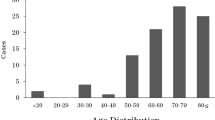Abstract
Purpose of Review
The purpose of this review is to describe the epidemiology and species distribution of fungi-causing keratitis in Argentina during the past 10 years.
Recent Findings
In Argentina, reports of distribution and frequency of fungal keratitis are scarce and little is known about its current epidemiology.
In the present study, a review of the published data on fungal keratitis was done according to the global context focusing on the current situation in our country.
Summary
Data presented here were obtained in a reference ophthalmological hospital in the Autonomous city of Buenos Aires from 2007 to 2017 and represents an approach to the current status of fungal keratitis. However, larger national data is required to assess the actual epidemiological situation in Argentina.
Similar content being viewed by others
References
Papers of particular interest, published recently, have been highlighted as: • Of importance •• Of major importance
• Whither J, Srinivasan M, Upadhyay M. Corneal blindness: a global perspective. Bull World Health Organ. 2001;79:214–21. This article emphasizes the importance of corneal diseases as a cause of blindness worldwide, second only to cataract.
• Xie L, Zhong W, Shi W, Sun S. Spectrum of fungal keratitis in North China. Ophthalmol. 2006;113:1943–8. This article not only describes the etiological agents that cause mycotic keratitis in 596 eyes, but also the associated risk factors. In addition, it recommends the diagnosis with HOK due to the low cost and easy access, and early surgery as treatment.
Ho J, Fernandez M, Rebong R, Carlson A, Kim T, Afshari N. Microbiological profiles of fungal keratitis: a 10-year study at a tertiary referral center. J Ophthalmic Inflamm Infect. 2016. https://doi.org/10.1186/s123480160071.
Chang H, Chodosh J. Diagnostic and therapeutic considerations in fungal keratitis. Int Ophthalmol Clin. 2011;51:3–42.
Ibrahim MM, Vanini R, Ibrahim FM, Fioriti LS, Furlan EM, Provinzano LM, et al. Epidemiologic aspects and clinical outcome of fungal keratitis in southeastern Brazil. Eur J Ophthalmol. 2009;19:355–61.
Saha R, Das S. Mycological profile of infectious keratitis from Delhi. Indian J Med Res. 2006;123:159–64.
Cheikhrouhou F, Makni F, Neji S, Trigui A, Sellami H, Trabelsi H, et al. Epidemiological profile of fungal keratitis in Sfax (Tunisia). J Mycol Med. 2014;24:308–12. https://doi.org/10.1016/j.mycmed.2014.06.047.
Müller GG, Kara José N, Castro RS. Epidemiological profile of keratomycosis at the HC-UNICAMP. Arq Bras Oftalmol. 2012;75:247–50.
Gupta A, Capoor MR, Gupta S, Kochhar S, Tomer A, Gupta V. Clinico-demographical profile of keratomycosis in Delhi, North India. Indian J Med Microbiol. 2014;32:310–4.
Srinivasan M, Gonzales CA, George C, Cevallos V. Epidemiology and aetiological diagnosis of corneal ulceration in Madurai, South India. Br J Ophthalmol. 1997;81:965–71.
Liesegang TJ, Forster RK. Spectrum of microbial keratitis in South Florida. Am J Ophthalmol. 1980;90:38–47.
Varaprasathan G, Miller K, Lietman T, Whitcher JP, Cevallos V, Okumoto M, et al. Trends in the etiology of infectious corneal ulcers at the F. I. Proctor Foundation. Cornea. 2004;23:360–4.
Ritterband DC, Seedor JA, Shah MK, Shah MK, Koplin RS, McCormick SA. Fungal keratitis at the New York Eye and Ear Infirmary. Cornea. 2006;25:264–7.
Pachigolla G, Blomquist P, Cavanagh HD. Microbial keratitis pathogens and antibiotic susceptibilities: a 5-year review of cases at an urban county hospital in North Texas. Eye Contact Lens. 2007;33:45–9.
Gopinathan U, Sharma S, Garg P, Rao GN. Review of epidemiological features, microbiological diagnosis and treatment outcome of microbial keratitis: experience of over a decade. Indian J Ophthalmol. 2009;57:273–9.
Bharathi MJ, Ramakrishnan R, Meenakshi R, Mittal S, Shivakumar C, Srinivasan M. Microbiological diagnosis of infective keratitis: comparative evaluation of direct microscopy and culture results. Br J Ophthalmol. 2006;90:1271–6.
•• Mellado F, Rojas T, Cumsille C. Fungal keratitis: review of diagnosis and treatment. Arq Bras Oftalmol. 2013;76:52–6. This article compares the sensibility and specificity of the different diagnosis methods available for fungal keratitis. It also provides recommendations for their treatment.
Badiee P, Nejabat M, Alborzi A, Keshavarz F, Shakiba E. Comparative study of gram stain, potassium hydroxide smear, culture and nested PCR in the diagnosis of fungal keratitis. Ophthalmol Res. 2010;44:251–6.
Thomas P, Kaliamurthy J. Mycotic keratitis: epidemiology, diagnosis and management. Clin Microbiol Infect. 2013;19:210–20.
Hariprasad SM, Mieler WF, Lin TK, Sponsel WE, Graybill JR. Voriconazole in the treatment of fungal eye infections: a review of current literature. Br J Ophthalmol. 2008;92:871–8.
Shi W, Wang T, Xie L, Li S, Gao H, Liu J, et al. Risk factors, clinical features, and outcomes of recurrent fungal keratitis after corneal transplantation. Ophthalmology. 2010;117:890–6. https://doi.org/10.1016/j.ophtha.2009.10.004.
Cinquegrani M. Queratitis micótica en el Hospital Oftalmológico Doctor Enrique Demaría. Tesis de maestría en Micología Medica. Facultad de Medicina Universidad Nacional del Nordeste. 2016. https://med.unne.edu.ar.
• Cabral D, Cattana M, Sosa M, Fernández M, Rojas F, Giusiano G. Agentes productores de úlceras corneales de origen fúngico en el nordeste argentino. XXIII Congreso Argentino de Micología y XXII Jornadas Argentinas de Micología. Lilloa 2014; 51(supl): 135. This is the first article that describes the prevalence of mycotic agents that cause keratitis in the Northeast of Argentina.
Leck AK, Thomas PA, Hagan M, Kaliamurthy J, Ackuaku E, John M, et al. Aetiology of suppurative corneal ulcers in Ghana and South India, and epidemiology of fungal keratitis. Br J Ophthalmol. 2002 Nov;86:1211–5.
Wilhelmus K. Climatology of dematiaceous fungal keratitis. Am J Ophthalmol. 2005;140:1156–7.
Ibrahim MM, De Angelis R, Lima AS, Viana de Carvalho GD, Ibrahim FM, Malki LT, et al. A new method to predict the epidemiology of fungal keratitis by monitoring the sales distribution of antifungal eye drops in Brazil. PLoS One. 2012;7:e33775. https://doi.org/10.1371/journal.pone.0033775.
Author information
Authors and Affiliations
Corresponding author
Ethics declarations
Conflict of Interest
The authors declare that they have no competing interests.
Human and Animal Rights and Informed Consent
This article does not contain any studies with human or animal subjects performed by any of the authors.
Additional information
This article is part of the Topical Collection on Clinical Mycology Lab Issues
Rights and permissions
About this article
Cite this article
Minervini, P., Albera, P. & Villada, M. Fungal Keratitis: Epidemiological Profile in Argentina. Curr Fungal Infect Rep 12, 144–148 (2018). https://doi.org/10.1007/s12281-018-0325-x
Published:
Issue Date:
DOI: https://doi.org/10.1007/s12281-018-0325-x




